HTC Vive Review: A Beautiful Machine With One Major Flaw: LeadTech is still in beta !
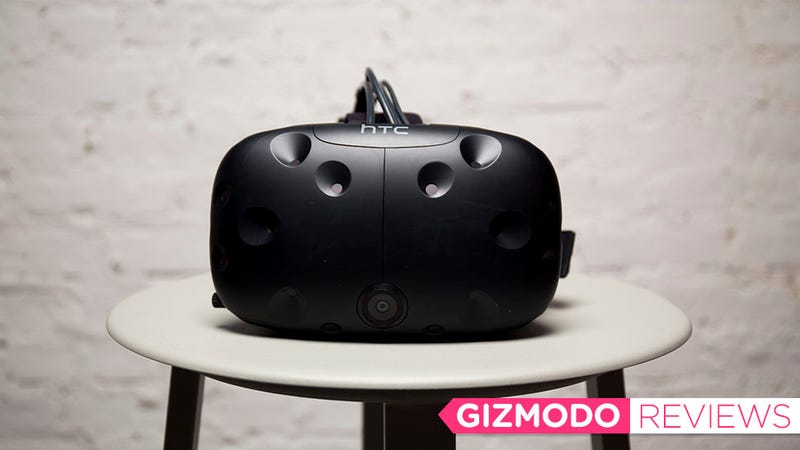
Virtual reality has always been an expensive hobby. Even in 1995, when the only VR option was the Nintendo Virtual Boy, it was hard to justify spending money on the device. It was uncomfortable to wear. It didn’t have any good games. And it was a little ahead of its time. Fast forward to this week, and after spending hours playing with the HTC Vive, I can safely say that VR is still an overpriced novelty.
The HTC Vive is the most advanced VR system ever sold. Its headset is ridiculously powerful, so you can look around in all directions without a hitch. Its wireless controllers make it easy to interact with objects in the virtual world. Even cooler than all that, the Vive lets you walk around in the game—which sets it apart from every other VR headset ever made.
Yeah, I know, the Oculus Rift is legit, but it just doesn’t offer the same type of immersion. If you ever wanted to stand up, walk around, duck, or lunge in the virtual world, the Vive is the only system that will let you do that. The company suggests a 6-foot by 5-foot area for your VR activities, but you can also do “standing room only” or go even bigger that 6×5. The Vive is entirely customizable when it comes to setting up a playing area.
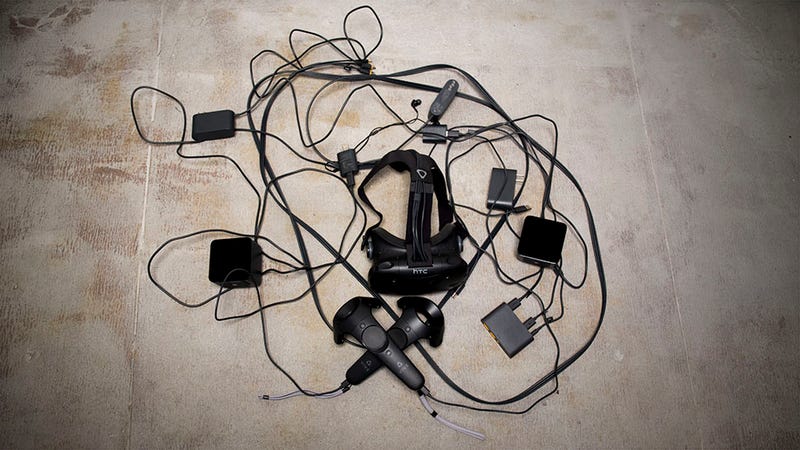
But that customizability is also its greatest flaw. There’s so much…stuff, and setting it up is a huge pain in the ass. The Vive ships in one gigantic box, about the size of a mini fridge, and inside that box are two wireless controllers, two base stations, a headset, and a bridge for connecting the headset to your PC.
And each accessory has at least one cable running to it. Finding the right slot for all of the different cables proved to be annoying—even for someone who spends every waking hour focused on technology. The system requires a total of five power outlets: two for the controllers, two for the base stations, and one for the bridge that connects the headset to the PC. You’ll also need power running to the PC and the monitor. So if you’re clearing out space for a new HTC Vive, you’d better have a room with plenty of wall outlets.
It took me almost an hour to get all of the accessories plugged into the right places. Once everything was connected, I got to the easiest part of the setup, downloading Steam and installing games. After all the software installation I had to calibrate the controllers, the headset, and the playing area. It was not easy, or quick, but finally—it was time to play some games.
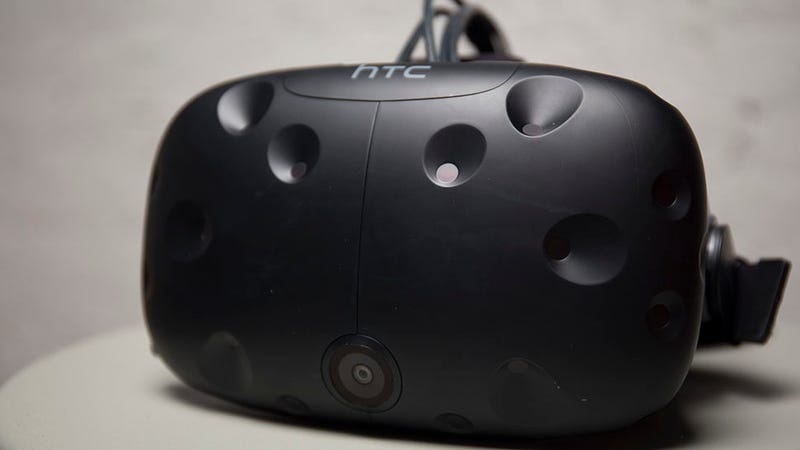
An Immersive Experience Devoid of Content
The HTC Vive’s goggles are heavy—noticeably heavier than the Oculus Rift’s. They’re heavier than a bike helmet, heavier than a baseball cap, heavier than scuba goggles, and probably heavier than anything you’ve ever put on your face.
But it’s a small price to pay for walking around in a virtual space, especially if you’re excited about it, so most people will probably disregard the excruciating weight of the plastic headset. I know I did. I tightened the straps on both sides of the goggles and buckled in. I was ready to explore.
The first game I booted up was Job Simulator: the 2050 Archives. It’s a favorite among Vive owners because it takes advantage of the system’s best features, especially the wireless controllers and positional tracking.
The game takes place in an office cubicle, and you’re asked to walk around and complete menial tasks like the faceless corporate employee that you are. Thankfully, the game adds some humor to make the ordeal worthwhile. You use both controllers to operate your hands in the game. When you hold a trigger on either controller, your hands grasp any nearby objects. You can hold objects, throw them, knock them over, and do just about anything you’d be able to do in real life. The positional tracking was even more intuitive. You just walk around in real life, and the system automatically mimics your movement in the game. It’s incredibly realistic (considering that all the animation is styled like a children’s cartoon) and plays to the Vive’s primary strength: unparalleled immersion.
I had a lot of fun playing the easy challenges (I have some experience working in an office). After breezing through a couple of missions, I decided to take a break…and realized an hour had passed. It was a little disorienting, but with the sole mission of playing video games all day, I decided to carry on. I turned offJob Simulator and booted up something else.
More specifically, I started playing Fantastic Contraption—a game that lets you build crazy machines using drag-and-drop tools. The goal is to get a pink ball into a pink goal by any means necessary. It’s far and away my favorite of all the Vive games, and I spent about 90 minutes beating the first couple of levels. When I realized there are 50 levels in the entire game and I wouldn’t be able to finish it in a night—at least reasonably—I decided to try something new.
And here’s where I hit a major block. I played Adventure Time: Magic Man’s Head Games, Elite Dangerous, #SelfieTennis, Tilt Brush, Cloudlands: VR Mini Golf, Hover Junkers, and several other launch titles, and none of them were any good. I desperately wanted to get lost in an expansive virtual world. I wanted to be attached to characters or stories that I’ve never seen or heard of before. I wanted to lose track of time. I wanted to play Minecraft or The Sims or Super Mario Bros. or any game that would sweep me away for hours.
But the HTC Vive isn’t launching with games like that (beyond the singular, but still pretty spare, Fantastic Contraption). It’s launching with a bunch of half-baked titles that would be better off bundled together in a sale bin. The games were perfect for a quick session or demonstration of the Vive’s badass technology—but they didn’t leave me itching for more.

Beware Your Surroundings
I experienced a lot of discomfort during my playing sessions, especially after a few hours. The weight of the headset and the cable were a big issue. I almost tripped over the chunky cable running to the headset several times. I also ran into the wall a few times because my system wasn’t calibrated right.
It’s kind of dangerous to play the HTC Vive alone. The headset has a built-in front-facing camera that’s supposed to warn you if you’re getting close to objects in the real world, but that doesn’t help with the world to either side of you. I found that it was still totally possible for me to swing my arms into nearby objects that went undetected by the Vive’s camera. In one session of#SelfieTennis, I swung my virtual racket fast and hit my hand (in real life) against the window. Ouch.
Switching games isn’t easy, either. The headset was hard to take off, especially alone with two controllers in your hands. It’s easy to start fumbling VR accessories if you don’t have a table nearby. You can launch new games from within the helmet—the UI is virtually identical to Steam’s “Big Screen” Mode—but I had difficulty reading its small lettering on the display. I also began experiencing the screen door effect after hours of use—something I never imagined possible in the final version of Vive.
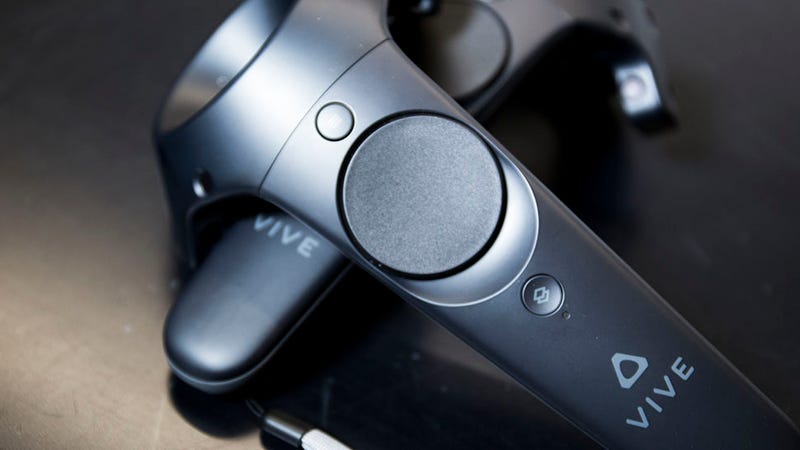
But I Still Can’t Quit You
It’s not as bad as it sound. Really.
The HTC Vive is without a doubt the most cutting-edge gadget you can buy right now. Its capabilities surpass any other device on the planet, and for that alone, it deserves to be celebrated. Whether it’s worth the $800 (that doesn’t include the additional $900 or so for the gaming computer) is a different story.
Valve, the company that created SteamVR, used many of its popular video game characters in early HTC Vive games. For instance, the Vive’s setup menu uses characters from the popular game Portal, while Surgeon Simulator VR: Meet the Medic uses characters from another popular Valve game, Team Fortress 2.
That gives me reason to believe (or hope) that Valve is developing some worthwhile VR versions of its best games. If that’s the case, I’ll be ready to celebrate when they arrive. Until then I’m going to be watching the Oculus Rift game catalog with envy while clutching my far superior Vive to my chest.
Come on you chunky monkey, get relevant.
README
- HTC Vive is the most advanced consumer electronics gadget you can buy. If you love tech, you’ll love the Vive.
- It’s a pain in the ass to set up. Bring beer.
- Don’t actually bring beer. The Vive experience is more immersive than the Oculus Rift and you could hurt yourself if you add booze.
- Unlike the Rift, the Vive ships with wireless controllers that fully realize the promise of realistic interactions in a virtual world.
- The games are weak. Let’s just hope that Valve steps up to the plate and creates VR games for popular titles like Portal and Half-Life.



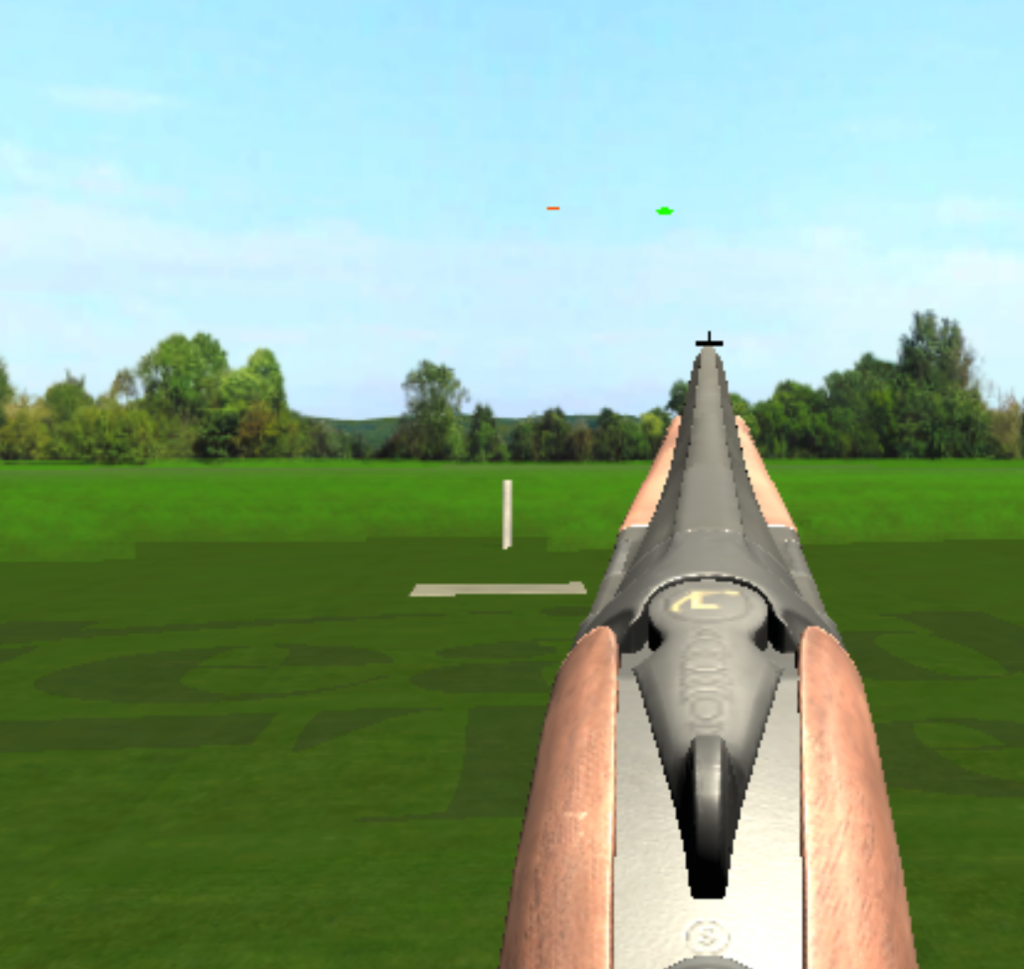

Leave a Reply